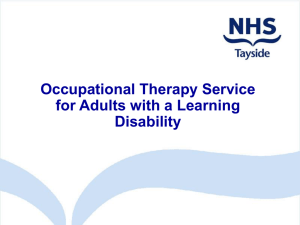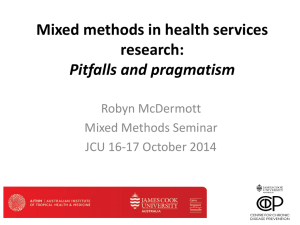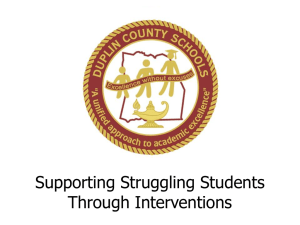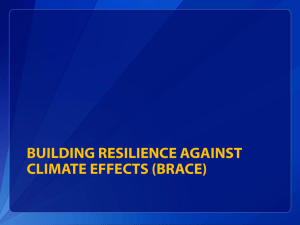Developing a School Success Plan (Powerpoint Presentation)
advertisement
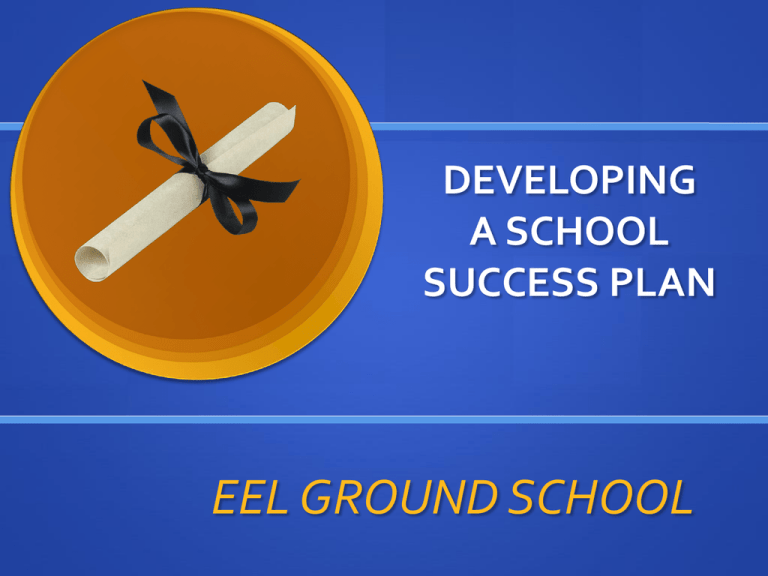
DEVELOPING A SCHOOL SUCCESS PLAN EEL GROUND SCHOOL SCHOOL SUCCESS PLAN A SIX STEP PROCESS DEFINE WHO WE ARE ASSESS WHERE WE ARE DETERMINE OUR STRENGTHS AND WEAKNESSES DEVELOP OUR GOALS IMPLEMENT OUR STRATEGIES AND INTERVENTIONS MEASURE AND EVALUATE OUR PROGRESS COMPONENTS OF THE SCHOOL SUCCESS PLAN Assessments that will be used to document program improvement Interventions that will be used to improve student performance Professional Development needed to implement the interventions Logistical/Action Plan that will support the implementation of the assessments, interventions and professional development. STEP ONE DEFINE WHO WE ARE SCHOOL PROFILE A concise, stand-alone document which gives a snapshot or picture of a school in data terms as a cycle of school improvement begins. MISSION STATEMENT A statement that identifies the priorities and educational beliefs of the school with regard to what is to be developed within its students. Create a school profile outlining the school demographics, programs, class sizes, etc. Review and clarify our School Mission statement Identify who will be on the SSP committee Establish time lines and communication procedures STEP TWO ASSESS WHERE WE ARE Assessment comes from performance measurements such as provincial assessments or standardized tests Factors that affect data are reviewed to determine their impact. These include economic, social and cultural differences. Data must be reliable, measured and collected over a period of time (three to five years). STEP THREE DETERMINE OUR STRENGTHS AND WEAKNESSES Strengths and weaknesses are determined through a review of the data The assessment has to be a collegial effort and the staff and school community have to have an ownership in it. Acknowledge that there are strengths as well as weaknesses in every school. Own what is ours. We have our own strengths and weaknesses and are limited by the resources we have. STEP FOUR DEVELOP OUR GOALS Once the profile is completed and the mission is written, it is time to write the student performance goals. Writing appropriate student performance goals is one of the most important steps in the development of the school success plan. Samples of Goals…. Every grade two student who has been in Eel Ground School since kindergarten will read at or above grade level when completing the grade two provincial achievement tests At least 75 percent of the grade four students who have been at Eel Ground School for one year will meet or exceed the provincial averages on the grade four writing assessment IMPLEMENT OUR STRATEGIES AND INTERVENTIONS STEP FIVE An intervention is something that is done to or with students that develops something desired within the student Interventions address the reasons why students are not being successful Start with findings (facts). Analyze to explain why the facts are what they are: intuitive analysis analysis using data research based For each explanation or reason, identify/determine the implications for interventions/strategies. GOOD INTERVENTIONS DEVELOP THE GOAL AREA WITHIN THE STUDENT They should do one of the following: Develop Knowledge Apply Knowledge Develop Patterns of Behavior Develop Attitudes KEY QUESTIONS ON INTERVENTIONS How many interventions needed for each goal? Can some interventions only address subgroups and not all students? Do all teachers have to do all interventions? Can some interventions cross over into other goals? INTERVENTIONS…. For every goal in a school success plan there is created at least one action plan page. This page contains all the details that go into the plan. The important word here is details. Always provide more information than you think necessary Details what has to be done to implement the interventions Who will do what and when? STEP SIX MEASURE AND EVALUATE OUR PROGRESS Assess the goal by administering some type of assessment that is comparable to the pre-intervention assessment. e.g. provincial assessment or district test Determine if the intervention improved the criterion stated in the goal. e.g. Did students do as well as NB students on their grade four writing assessment Evaluate outcome. Was the goal achieved? Will the intervention still be required? If the goal has not been achieved, what else can be done? WHAT CAN WE LEARN FROM THIS DATA? WHAT OTHER INFORMATION WOULD BE HELPFUL? WHAT GOAL COULD BE STATED? WHAT INTERVENTIONS COULD BE USED? Remember to celebrate every successful moment that you have as you work toward your goal. Praise, encouragement and recognition will go a long way as you try to achieve your goal!




